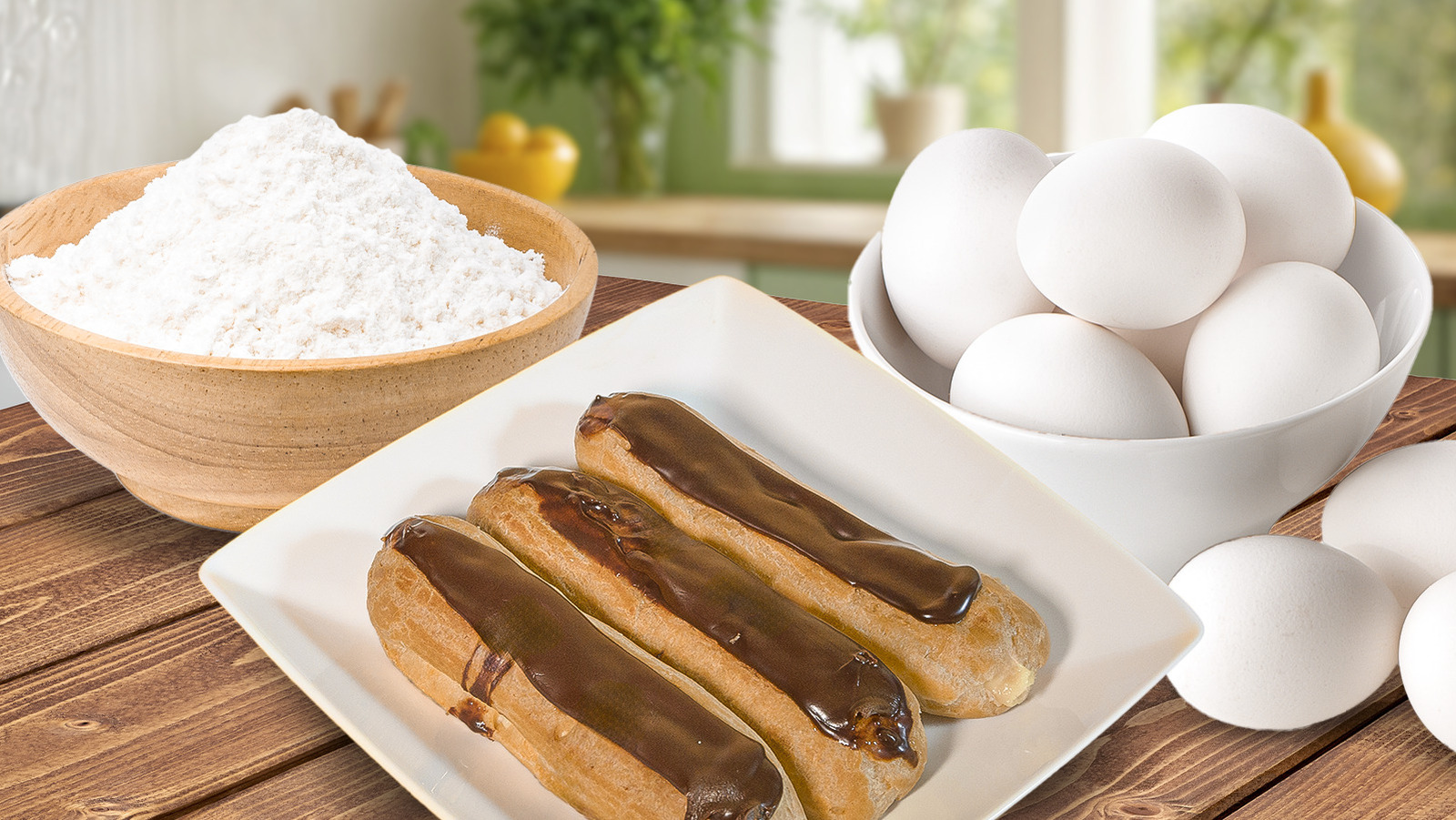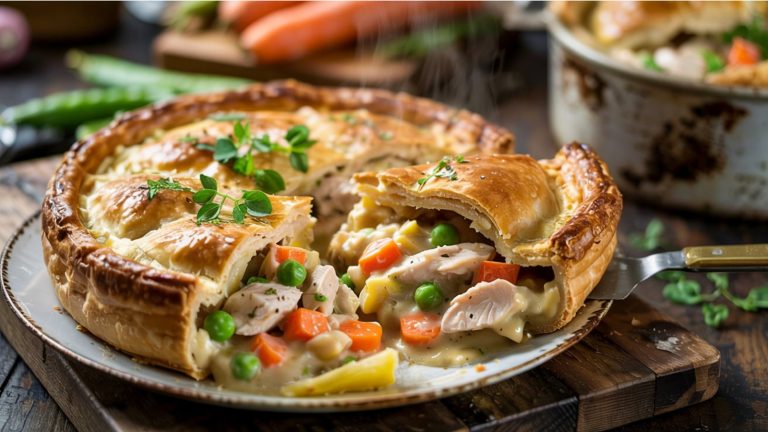Eclairs are a French pastry known for their long, finger-like shape and pastry cream filling. Add a layer of chocolate ganache to the top and you have the classic chocolate eclair. Like their smaller, rounder cousins, cream puffs, eclairs start with a dough called pâte àu choux. Also known as choux paste, it starts as a blend of simple pantry staples. Skillfully combine water or milk, butter, flour, and eggs to produce a cross between a dough and a batter. Add in a healthy dose of science and steam, and these pantry basics morph into the puffy, crispy, pastry cream-filled treats we love. While the fillings and toppings may vary, the foundational elements remain more or less the same — a crisp pastry shell stuffed with a creamy filling and a delicious glaze on top.
In culinary school, I made pâte àu choux countless times until I could prepare them perfectly without a recipe. The focus was instead on the ratio of ingredients. Years later, when I needed a simple but elegant dessert for my personal chef and catering clients, I could whip up a batch of eclairs with ease. This was due in large part to the tips and tricks I’d learned along the way. Put these nine tips to use for perfect eclairs from scratch every time, without going to culinary school.
1. Choose the right pan
Choosing the right tools is an integral part of cooking any recipe, especially when making eclairs. Attempting to prepare them in the wrong pan could be disastrous, so it’s crucial to select a pan with the qualities you need to succeed. It’s important to use a pan not only large enough to hold all of your ingredients but also allows room for stirring and mixing the dough. You also need a pan with relatively tall sides. This is no job for a wide, shallow cookware like a saute pan or skillet. That type of pan will give you too much surface area to mix the dough properly.
The ideal pan for making pâte àu choux should hold two to four quarts. Look for a pan that’s 7 to 8 inches wide. This will give you lots of room to move the dough around once it’s formed. High sides are also essential for the pan you use to make eclairs. They’ll make it easier to stir the dough. In addition to the pan that you’ll mix your dough in, you should also choose a rimmed baking sheet for baking your eclairs. Line it with parchment to prevent the dough from sticking.
2. Weigh the flour
Precision is important when you’re baking. With savory cooking, you can often get away with a little more or less of an ingredient, and you likely won’t notice the difference, such as an extra carrot in your chicken noodle soup. However, using the wrong amount of an ingredient when you’re baking can be disastrous because there’s science behind the way ingredients work together. Measuring your ingredients accurately is especially important when you’re making pâte àu choux for eclairs. Flour is an ingredient that’s easy to measure incorrectly, and the wrong amount can ruin your eclairs. Adding too much flour to your choux paste will yield eclairs that are dense, hard, and flat. Too little flour and your eclairs will likely come out soggy and shapeless.
It’s easy to get your flour measurements wrong largely because most people don’t know the proper way to measure it. Raise your hand if you’ve scooped your measuring cup into a bag of flour, then dumped it into your mixing bowl. My hand is raised with you in spirit. I did this routinely before I went to culinary school, but this is the worst way to measure flour. Scooping compresses the flour in the measuring cup so you end up with more than you need, even if you use a fork or whisk to aerate the flour after scooping. The best way to measure flour is to weigh it. You’ll get a much more accurate measure this way than measuring it by volume.
3. Use milk and water
Cooking with liquids is nothing new. If you’ve ever whipped up a braised dish like coq au vin and beef stew or any type of soup, you’ve undoubtedly cooked with a liquid. While most recipes call for a flavorful liquid like chicken stock or a bold red wine, pâte àu choux relies on far simpler options — water or milk. Sure, you can use one or the other, but the best eclairs are made with both. Each brings its own set of characteristics to your eclairs so combining them gives you the best of both worlds. Aim to make up the liquid portion with half milk and half water for the best results.
Eclairs made with all water will bake up crisp and airy, creating the perfect eclair texture. They won’t end up as brown as those made with milk, but the water will produce more steam that will give your eclairs more lift. Using milk alone will give you eclairs with a beautifully browned crust but little rise. The additional sugar and protein naturally present in milk cause this intense browning and give it shape. Using both milk and water will give eclairs the benefits of both ingredients. Adventurous bakers can also experiment with other liquids like teas or infused waters for added flavor.
4. Add the flour all at once
Eclairs may sound like a fancy French recipe, but making them is easier than you might think. Unlike other French desserts like fluffy soufflés or crème brûlée, which require more delicate cooking techniques like folding and tempering, making eclairs is — in many ways — a dump-and-stir recipe. Once the water or milk comes to a boil, the next step is to add the flour. The key thing to remember when it’s time to add the flour is not to hesitate. You need to take the pan off the heat and dump the flour in all at once.
The point of adding the flour all at once is to jolt the flour with the sudden temperature change. This makes it easier for the flour to better absorb the water, milk, or both. Once the flour is in the pan, you’ll need to stir it forcefully until the flour absorbs all of the liquid and a dough has formed. Your work is not done when the flour and liquid transform into a dough. You’ll need to return the pot back to the heat and continue stirring it constantly until any excess moisture evaporates. Any extra liquid in your choux paste may result in your eclairs not rising properly when they’re baked.
5. Pay close attention to temperature
Making eclairs is both simple and complicated. The steps you take to prepare them are simple — boil the liquid, dump the flour, stir in the eggs, pipe, bake, and fill, but there are seemingly small things you have to keep an eye out for to ensure your eclairs turn out perfectly. Temperature is one of those details. Maintaining the appropriate temperature is critical in each stage of making eclairs. While the temperature of the oven when you bake your eclairs is important, it’s equally important to pay close attention to the temperature of the dough while you’re incorporating ingredients and the temperature of the eclairs once they’re baked.
You first need to make sure the butter and the liquid you’re using get hot enough to come to a full boil. You need the high heat to help start cooking the flour when it’s added. Temperature is especially important when incorporating the eggs into the dough. Give the dough a few minutes to cool down slightly so that it’s not so hot that it scrambles the eggs when they’re added. Only add the eggs when your dough reaches a temperature of 145 degrees Fahrenheit or below. Once your eclairs are baked, resist the temptation to fill them with pastry cream or other fillings right away. Warm eclairs will melt the filling, so allow them to come to room temperature before you add the cream.
6. Add eggs one at a time
Adding the eggs to your cooked dough may be the trickiest part of making eclairs. Not only do you have to pay close attention to the temperature of the dough before you add in the eggs, but you also have to be just as diligent about the manner in which you add the eggs to your mixing bowl. Unlike the flour, which should be added all at once, it’s imperative that the eggs are incorporated into the dough slowly, one at a time. Pâte àu choux dough can be tricky because the amount of eggs you add to it can vary depending on factors like the humidity in your kitchen, which can affect the amount of liquid your dough can easily absorb. So, add one egg at a time and mix or stir until that egg is fully incorporated into the dough. Repeat this until the dough reaches the proper consistency.
The goal is to get the dough smooth, glossy, and thick enough to cling to the beater and fall off slowly when you lift it out of the bowl. The mixture should come to a point as it slumps off the beater, creating a v shape. If you dismiss this advice and add the eggs all at once, you’ll easily risk adding more eggs than your dough actually needs and ruining the consistency. Your finished pâte àu choux dough needs to be at just the right consistency in order to bake properly.
7. Use a pastry bag
The tools you need to make eclairs are simple — a deep pot, a wooden spoon or spatula, and a baking sheet lined with parchment paper for baking them. You also need a tool to get the choux paste in the right shape. You want to craft eclairs that are all the same shape and size. This is made simple with a pastry bag. Though they’re typically used for cake decorating, tasks like piping macarons and deviled egg filling are also great uses for your pastry bag. Pastry bags are also an easy way to make eclairs that are uniform in size. We want eclairs that are about the same size so they finish cooking around the same time.
If pastry bags aren’t a tool you use often enough to have them on hand in your kitchen, don’t worry. You can get equally precise results using a large, resealable plastic bag, like a Ziploc bag. Fill the bag with your pastry cream or other filling and squeeze the bag until the filling is settled in a corner of the bag. Use kitchen shears to cut off the tip of that corner, and you’re ready to pipe. Whether you use a piping bag or a plastic bag to fill your eclairs, you should pipe your eclairs so that they measure 5 inches long and between ½ and ¾-inch wide.
8. When in doubt, overcook them
With most baked goods, recipes instruct cooks to pay close attention to the cooking time and to remove the item from the oven as soon as it’s done. This is sage advice for most foods. If you bake a pound cake too long, it will likely end up dry and crumbly instead of moist and fluffy. An over-baked chocolate chip cookie can be brittle with a burnt taste that can overpower any other flavors in the cookie. This rule doesn’t apply to eclairs. In fact, if you’re unsure if you’ve given them enough time in the oven, it’s best to err on the side of caution and let them cook a little longer. It’s better to risk overcooking them than to serve them when they’re not fully baked.
Eclairs should be well browned and crisp and dry and airy inside. This can be difficult to achieve because of all of the moisture the dough used to make them contains. Cooking them a little longer than the recipe calls for likely won’t ruin your eclairs. The extra time in the oven will ensure that they are beautifully browned and crisp. The crispness will prevent them from deflating when they’re removed from the oven. It will also make sure the centers have an opportunity to dry completely. For best results, start baking your eclairs at a high temperature of 425 F until they are browned. Then, lower the temperature and bake at 350 F to finish cooking the centers.
9. Fill them just before serving
There’s nothing more convenient than a delicious, make-ahead dessert. Whether you’re baking a classic apple crisp for a dinner party with friends or chilling a creamy, decadent chocolate mousse for a sweet after-dinner bite, preparing a dessert before the rush of your event begins is both a time saver and stress reducer. Eclairs fall into this make-ahead dessert category, but not in the way you might think. Pâte au choux dough can be made ahead and stored in the fridge for up to three days before you bake it. It will last in the freezer for up to three months. You’ll need to thaw it thoroughly before piping and baking it. Another option is to pipe and shape the eclairs before freezing, and when you’re ready, just bake them without thawing. You can also freeze baked, unfilled eclairs for as long as a month.
Though the choux paste can be made ahead baked or unbaked, it’s important to wait to fill your eclairs until just before you’re ready to serve them. Eclairs should be crisp and somewhat firm on the surface and dry and airy inside. Once they’re filled, the moisture in the filling will cause the eclairs to soften. Waiting to fill your eclairs will give you a wonderful contrast of textures. You’ll enjoy the crispness of the outside and the cool, creaminess of the filling and skip the soft, soggy texture that will come from allowing them to sit, filled, for too long.





